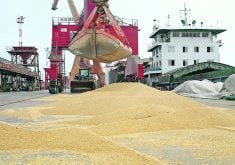Analysts expect the biggest barley crop since 2009, despite information refuting rumours that maltsters are desperate for supply
Farmers must have been in a secretive mood when they told Statistics Canada how much barley they were going to seed this year.
The official estimate calls for 6.4 million acres of the crop.
“I think they’re out to lunch,” said Rod Green, owner of Central Ag Marketing, a grain broker specializing in malt barley.
“It’s more like around 7.5 million acres, which I’ve been predicting over the last three months.”
It is the same number that grain industry analyst Greg Kostal is forecasting, which would be a 28 percent increase from last year.
Read Also

Flax sector sees omega-3 opportunity
SASKATOON — A global shortage of omega-3 oils could be an opportunity for the flax sector, says an industry official….
If they are right, it would be the biggest barley crop since 2009, which is a good thing because last year was a disaster in terms of yield and quality.
“We seem to be getting back up to some more sustainable acreage,” said Green.
New crop prices for malt barley have been appealing compared to other crops, with malting companies offering to pay $5.40 to $5.50 per bushel at the bin.
That has reignited farmer interest in the crop, with most of the acreage increase occurring in Saskatchewan.
There have been reports that maltsters are running out of malt barley and will be desperate to secure supplies right off the combine this fall, but Green, who deals with five malting companies, said that is false.
“In actual fact, all the maltsters today are pretty well full. They’re not really looking for any more. They’ve got enough to take them through harvest,” he said.
They were able to compensate for poor germination and extensive chitting in the 2014-15 crop by relying on carryout from the previous year, lowering their quality specifications and importing product from overseas.
Ron Volpi, vice-president of supply with Rahr Malting, agreed that supplies are not as tight as some people think.
“I believe everybody has enough to go until the new crop is available,” he said.
“I know that we have enough and we will slowly start bringing in new crop as it comes available. That wouldn’t be too different from what normally happens.”
He believes there will be ample supply in 2015-16 and is forecasting a 15 percent increase in Canadian barley acres. However, he acknowledged it could be higher because of the recent weakness in wheat prices.
“I don’t know if that will make people swing from wheat to barley more at the last minute. That could happen,” said Volpi.
“I would say it’s likely that some last minute barley acres will pop up.”
Green doubts that will happen because seed growers are essentially sold out of good quality malt barley seed because of last year’s germination and chitting problems.
“For the last three months you have not been able to find a bushel of certified (CDC) Copeland barley,” he said.
Green said malt barley prices are good, but feed barley prices are not, so growers are taking a big risk when they try to grow barley for malt.
Maltsters typically buy about one million tonnes of the crop, and grain companies export another million tonnes. That leaves more than five million tonnes to be sold as feed.
Feed prices may be stronger than last year at this time but are not attractive. They are depressed because of the small number of cattle in Canadian feedlots and low corn prices caused by excess U.S. production in 2014-15.
The feed price is about $4 per bu. delivered to Lethbridge, so the spread between malt and feed barley is much more than $1.50 per bu.
Contact sean.pratt@producer.com
















